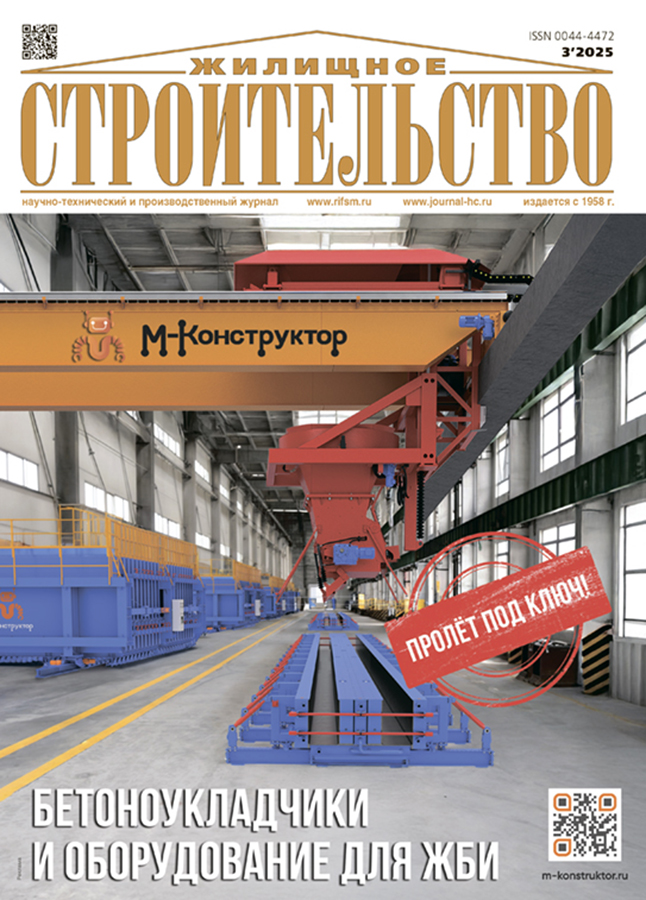Vibroacoustic aspects of accommodation and public spaces in over-track structures
- Authors: Smirnov V.A.1,2, Malov D.D.1, Garber E.O.1,2
-
Affiliations:
- Scientific-Research Institute of Building Physics of RAACS
- National Research Moscow State University of Civil Engineering
- Issue: No 3 (2025)
- Pages: 33-38
- Section: Articles
- URL: https://ruspoj.com/0044-4472/article/view/679477
- DOI: https://doi.org/10.31659/0044-4472-2025-3-33-38
- ID: 679477
Cite item
Abstract
Rail transport is one of the main sources of vibroacoustic impact on the surrounding area. Provision of comfortable living environment for the population is one of the priority tasks of engineering, technical and socio-economic importance. At the same time, construction of over-track buildings and structures within the boundaries of influence of linear objects can become one of the promising directions of urban environment development. However, the close location of the source of rail transport makes their use difficult. Fast and accurate prediction of vibration levels caused by train operation, its impact on the environment and effective recommendations for comprehensive vibration reduction and isolation design are the basis for promoting rapid and favourable development of rail transport.
Full Text
About the authors
V. A. Smirnov
Scientific-Research Institute of Building Physics of RAACS; National Research Moscow State University of Civil Engineering
Author for correspondence.
Email: belohvost@list.ru
Candidate of Sciences (Engineering)
Russian Federation, 21, Lokomotivniy Driveway, Moscow, 127238; 26, Yaroslavskoe Highway, Moscow, 129337D. D. Malov
Scientific-Research Institute of Building Physics of RAACS
Email: malovdavid97@mail.ru
Engineer
Russian Federation, 21, Lokomotivniy Driveway, Moscow, 127238E. O. Garber
Scientific-Research Institute of Building Physics of RAACS; National Research Moscow State University of Civil Engineering
Email: grenadefleur@gmail.com
Engineer
Russian Federation, 21, Lokomotivniy Driveway, Moscow, 127238; 26, Yaroslavskoe Highway, Moscow, 129337References
- Larina N.A. Railway territories – prospects for the development of the city of Moscow. Arkhitektura i Sovremennye Informatsionnye Tekhnologii. 2014. No. 3 (28), p. 6. (In Russian). EDN: QWHBAR
- Nye T. Construction above, adjacent to and under future and existing rail infrastructure. In CORE 2016: Maintaining the Momentum. Melbourne: Railway Technical Society of Australasia, Melbourne. 2016, pp. 540–549. https://search.informit.org/doi/10.3316/informit.435208753903374
- Price B. Development: out of thin air: the potential for high-rise housing over rail lines. CTBUH Journal. 2018. No. 3, pp. 34–41. https://www.jstor.org/stable/26768091
- Zou C., Wang Y., Moore J.A., Sanayei M. Train-induced field vibration measurements of ground and over-track buildings. Science of The Total Environment. 2017. No. 575, pp. 1339–1351. https://doi.org/10.1016/j.scitotenv.2016.09.216
- Zou C., Wang Y., Wang P., Guo J. Measurement of ground and nearby building vibration and noise induced by trains in a metro depot. Science of The Total Environment. 2015. No. 536, pp. 761–773. https://doi.org/10.1016/j.scitotenv.2015.07.123
- Kaskov Yu.N., Farkhatdinov G.A., Podkorytov Yu.I., Khusnutdinova N.S. Modern aspects of the state and improvement of sanitary and epidemiological welfare of workers and passengers of Russian railway transport. Gigiena i Sanitariya. 2013. Vol. 92. No. 5, pp. 24–26. (In Russian). EDN: RKRXGV
- Smirnov V.A., Savulidi M.Yu., Smolyakov M.Yu. Assessment of the impact of vibration on buildings and structures in the zone of influence of the railway. Zhilishchnoe Stroitel’stvo [Housing Construction]. 2022. No. 11, pp. 36–40. (In Russian). EDN: ZWPEY. https://doi.org/10.31659/0044-4472-2022-11-36-40
- Butorina M.V., Kuklin D.A., Matveev P.V., Oleinikov A.Yu. Evaluation of railway noise and development of noise protection measures. Vestnik of the Rostov State University of Railway Communications. 2019. No. 2 (74), pp. 57–65. (In Russian). EDN: MTHZNJ
- Blidberg K. Railway noise issues in Sweden. In Presentation held on 7th Annual Workshop on Railway Noise, Paris. 2011, November 8–9.
- Ruiz Sierra M.R. Noise Control Measures in Spanish Planning and Management. In Presentation held on 7th Annual Workshop on Railway Noise, Paris. 2011, November 8–9.
- Georges Kouroussis, Harris P. Mouzakis and Konstantinos E. Vogiatzis. Structural impact response for assessing railway vibration induced on buildings. Mechanics and Industry. 2007. https://doi.org/10.1051/meca/2017043
- Smirnov V.A. Protection of load-bearing structures of buildings from the influence of vibration created by railway transport. Zhilishchnoe Stroitel’stvo [Housing Construction]. 2020. No. 12, pp. 40–46. (In Russian). EDN: SYVYSQ. https://doi.org/10.31659/0044-4472-2020-12-40-46
- Ren X., Wu J., Tang Y., Yang J. Propagation and attenuation characteristics of the vibration in soft soil foundations induced by high-speed trains. Soil Dynamics and Earthquake Engineering. 2019. No. 117, pp. 374–383. https://doi.org/10.1016/j.soildyn.2018.11.004
- Connolly D.P., Kouroussis G., Laghrouche O., Ho C., Forde M.C. Benchmarking railway vibrations – track, vehicle, ground and building effects. Construction Building Materials. 2015. No. 92, pp. 64–81. EDN: XPBFMD
- Smirnov V., Cherkasova D., Lebedev A., Smolyakov M. Vibration data probability analysis inside residential premises adjacent to underground train lines. IOP Conference Series: Materials Science and Engineering: International Science and Technology Conference «FarEastCon 2019». Vladivostok, Russky Island, 2019, October 01–04. Vol. 753, 2, Chapter 1. Vladivostok: Institute of Physics Publishing, 2020. P. 022082. EDN: EXGGHX. https://doi.org/10.1088/1757-899X/753/2/022082
Supplementary files













